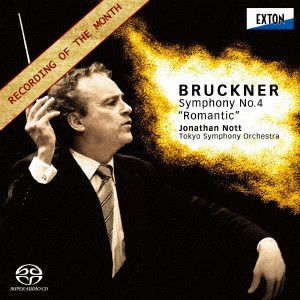
Anton Bruckner (1824-1896)
Symphony No. 4 in E flat major, ‘Romantic’ WAB 104 (1878/80 version – ed. Nowak)
Tokyo Symphony Orchestra/Jonathan Nott
rec. live, 16 October 2021, Suntory Hall, Tokyo
EXTON OVCL00796 SACD [70]
From the first shimmering tremolo bars overlaid by the smoothest of horn calls, this live performance of the version of this symphony which is the most often played sets just the right tone – and the weight of the orchestral entry underpinned by suitably prominent timpani confirms that sense of propriety. Nott’s tempi are to my taste ideal; they are on the “conventionally-leisurely” side, very similar to Karajan’s 1970 recording but with slightly slower first and second movements. The playing of the Tokyo Symphony Orchestra is flawless – mightily impressive – especially that of the principal horn and his fellow brass-players. This is one of those recordings where the listener need fear no flaws or idiosyncrasies but just sit back and let the music take over.
That excellence is enhanced by the sound engineering here: no distracting grunts from the conductor or coughs from the audience but an ambience as rich, warm and full as any studio recording, every strand of the score clearly and cleanly differentiated with ideal balances among the different sections and enormous heft in orchestral climaxes without overload. Nott is not pusillanimous when it comes to exploiting the maximum in dynamic range his orchestra can produce, as you may hear from the contrast between magnificent peroration to the first movement and the delicate opening to the Andante with its lovely melody for the cellos. The culmination of the slow movement is equally imposing, following Nott’s masterly control of its slow but inexorable tread. There is nothing much to say about the ‘Hunt’ Scherzo other than it is ideally executed with more superb playing from the brass section and flowing, relaxed Trio with just a hint of lilt – not very rustic, perhaps but so elegant. Nott is especially good at gauging the impact of climaxes to movements and for the third time while listening I feel as if a movement is given the conclusion it demands. That satisfaction is carried over and sustained by the manner in which Nott generates a sense of foreboding in the pounding opening to the finale, culminating in the first great outburst from the concerted brass at 1:24. The second explosion around 2:40 is again monumental and from then on, the tension never lets up over the twenty-three-minute span of this movement; mystery and menace are ever present, even during the woodwind “Alpine” interludes. I remark above upon Nott’s willingness to engineer dynamic contrasts; another fine example comes exactly half way through at around eleven and a half minutes in, when to thrilling effect he oversees the long, slow diminuendo and rallentando before another of those typically Brucknerian brass salvos at 11:54. Such is his control that he does not demand too much too soon but still has power in reserve; hence, first the pause and then the transition from the false ending at 16:30, before the unexpected reprise of the lyrical second theme introduced by the flute over pacing, pizzicato double bass, are both beautifully managed and there is still something in the tank for the fourth and final eruption capping the slow build-up of the ominous coda. There is a gratifyingly prolonged pause before the start of the deserved applause. This is the best thing I have heard from Nott.
It is striking how error-free the playing is here despite there being no lack of release in the music-making; this live recording combines artistry of the highest order with the precision of a studio account but without the safety-net of retakes. I am increasingly persuaded that if you want to hear Bruckner played to a consistent standard of excellence by conductors and orchestras wholly immersed in the idiom without falling prey to distracting idiosyncrasy, then Japan is where to go. There is an ever-growing catalogue of first-rate live recordings of Bruckner symphonies of that provenance; in addition to the Tokyo Symphony, whose recordings are on the Exton label, as per here, there are several more fine orchestras in the city, including the NHK, the Philharmonic, the New Japan Philharmonic and the Metropolitan, then others throughout Japan such as those in Osaka and Hiroshima, who live recordings of Bruckner on the Fontec and Brain Music labels I have previously reviewed, usually admiringly.
Ralph Moore
(This review posted here by kind permission of The Bruckner Journal who commissioned it.)
Availability: Musicjapanet

















